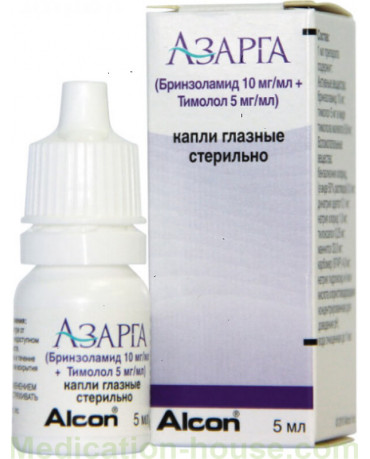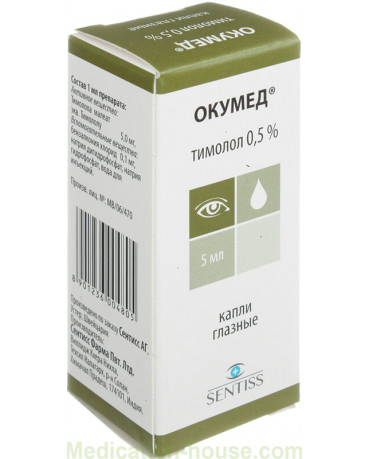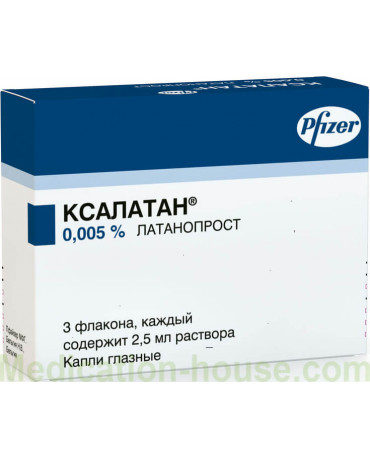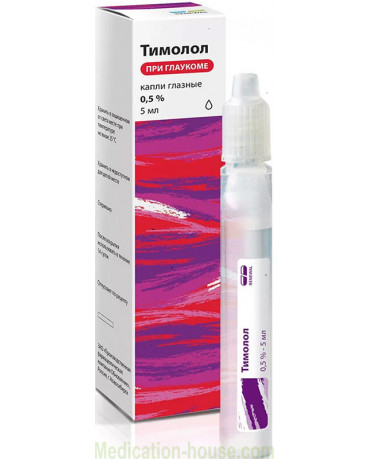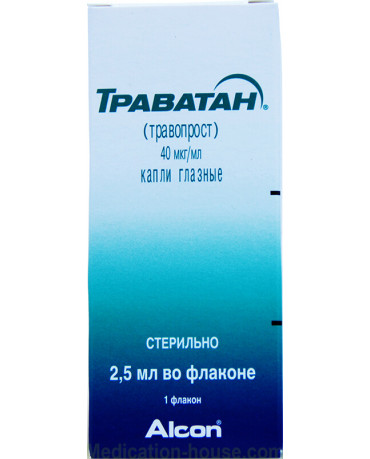Travapress user manual
Reed more and buy Travapress here
Release form and composition
The drug is available in the form of eye drops: a clear, colorless liquid (2.5 ml each in polyethylene dropper bottles, 1 dropper bottle in a cardboard box and instructions for using Travapress).
1 ml drops contain:
active substance: travoprost - 40 mcg;
auxiliary components: trometamol, boric acid, disodium edetate dihydrate, macrogol glyceryl hydroxystearate (Cremophor RH40), benzalkonium chloride, mannitol, sodium hydroxide solution 1M or hydrochloric acid solution 1M, purified water.
Pharmacodynamics
Travapress is an antiglaucoma drug, the active substance of which is travoprost, a synthetic analogue of prostaglandin F2α, a highly selective full agonist of prostaglandin FP receptors. A decrease in intraocular pressure occurs as a result of an increase in the outflow of aqueous humor through the trabecular network and uveoscleral tracts.
After instillation, the clinical effect is observed after about 2 hours, the maximum effect occurs after 12 hours. A single use of the drug contributes to a significant decrease in intraocular pressure, which lasts for 24 hours.
Pharmacokinetics
After instillation, travoprost is absorbed through the cornea of the eye and by hydrolysis is biotransformed to free acid travoprost (biologically active form of the substance). The maximum concentration (Cmax) of travoprost free acid in blood plasma is reached within 10–30 minutes, it is 25 pg / ml or less.
The elimination of the free acid of travoprost from the plasma occurs quickly, within 60 minutes after administration, its level is less than 10 pg / ml, that is, below the detection threshold. In this regard, the half-life (T1 / 2) of the free acid of travoprost has not been established.
The main route of elimination of travoprost and travoprost free acid is metabolism. The pathways of systemic metabolism are parallel to the pathways of endogenous prostaglandin F2α metabolism, which are characterized by the reduction of the double bond 13-14, oxidation of the 15-hydroxyl group, and beta-oxidative cleavage of the upper side chain unit.
Free acid travoprost and its metabolites are excreted mainly through the kidneys.
In case of impaired liver function of any severity and impaired renal function with creatinine clearance (CC) less than 14 ml / min, dose adjustment is not required.
Indications for use
The use of the eye drops is indicated for the reduction of increased intraocular pressure, including in open-angle glaucoma.
Contraindications
Absolute:
period of pregnancy;
breast-feeding;
age up to 18 years;
hypersensitivity to the components of the drug.
Travapress should be used with caution in acute inflammation of the organ of vision, aphakia, rupture of the posterior capsule of the lens, the existing risk of developing cystic macular edema, as well as in patients with an anterior chamber intraocular lens and / or risk factors for iritis and uveitis.
Instructions for use: method and dosage
Eye drops Travapress are applied topically, by introduction into the conjunctival sac of the eye.
After instillation, it is necessary to squeeze the nasolacrimal canal by pressing with a finger in the area of the inner corner of the eye. These measures will reduce the risk of developing systemic side effects of the drug.
Recommended dosage: 1 drop 1 time per day (in the evening).
If you accidentally skip the next injection of drops, you cannot double the next dose, treatment must be continued as usual.
If Travapress is prescribed in combination with other ophthalmic agents to reduce intraocular pressure, the interval between their introduction into the conjunctival sac of the eye should be 5 minutes or more.
In cases where Travapress is prescribed to replace another antiglaucoma drug, its use should be started the next day after the previous ophthalmic drug has been canceled.
After opening, the contents of the bottle remain stable for 28 days.
Side effects
According to the results of clinical studies, the general profile of adverse reactions showed that among the most common adverse events of Travapress are conjunctival injection and increased pigmentation of the iris.
The side effects described below are grouped according to the following classification: very often (≥ 1/10); often (from ≥ 1/100 to <1/10); infrequently (from ≥ 1/1000 to <1/100); rarely (from ≥ 1/10 000 to <1/1000); extremely rare (<1/10 000, including isolated cases); the frequency has not been established (the available data do not allow to establish the frequency of development of undesirable effects).
Possible side reactions from systems and organs when using Travapress eye drops:
on the part of the organ of vision: very often - conjunctival injection; often - itching in the eye, dry eye syndrome, eye pain, discomfort in the eye, hyperpigmentation of the iris, eye irritation; infrequently - lacrimation, discharge from the eyes, photophobia, erosion of the cornea, itching of the eyelids, uveitis, iritis, keratitis, punctate keratitis, blepharitis, erythema of the eyelids, edema of the periorbital region, blurred vision, decreased visual acuity, conjunctivitis, ectropion, crusts along the edges of the eyelids discoloration and / or increased growth of eyelashes, inflammation of the anterior chamber of the eye, asthenopia, cataracts; rarely - conjunctival edema, photopsia, eyelid eczema, eye inflammation, the appearance of rainbow circles around light sources, conjunctival folliculosis, meibomitis, ocular hypesthesia, pigment dispersion in the anterior chamber of the eye, thickening of eyelashes, mydriasis; frequency not established - drooping of the eyeballs, macular edema;
from the nervous system: infrequently - headache, dizziness, loss of visual fields; rarely - dysgeusia;
on the part of the immune system: infrequently - hypersensitivity reactions, seasonal allergies, hypersensitivity to other drugs;
on the part of the digestive system: rarely - dry mouth, constipation, disruption of the gastrointestinal tract, exacerbation of stomach ulcers; frequency not established - nausea, abdominal pain, diarrhea;
on the part of the cardiovascular system: infrequently - palpitations; rarely - irregular heartbeat, decreased heart rate (heart rate), decreased diastolic blood pressure (BP), increased systolic blood pressure, hypertension, hypotension; frequency not established - chest pain, tachycardia, bradycardia;
on the part of the organ of hearing and labyrinth: the frequency is not established - tinnitus, vertigo;
from the respiratory system: infrequently - nasal congestion, dyspnea, sore throat, asthma; rarely - cough, pain in the oropharynx, impaired respiratory function, dysphonia; frequency not established - aggravation of bronchial asthma symptoms;
on the part of the skin and subcutaneous fat: infrequently - skin discoloration, increased skin pigmentation in the periorbital region, hypertrichosis, changes in the structure of vellus hair; rarely - rash, allergic dermatitis, erythema, contact dermatitis, madarosis, discoloration of vellus hair; frequency not established - itching, impaired growth of vellus hair;
from the urinary system: the frequency has not been established - urinary incontinence, dysuria;
from the musculoskeletal system: rarely - musculoskeletal pain; frequency not established - arthralgia;
mental disorders: frequency not established - anxiety, depression;
infectious and parasitic diseases: infrequently - herpetic keratitis, eye infections (caused by Herpes simplex);
laboratory parameters: the frequency is not established - an increase in the level of PSA (prostate specific antigen);
others: infrequently - malaise; rarely asthenia.
Overdose
When Travapress is applied topically at a dose significantly higher than the recommended dose, the toxicity of the drug is unlikely.
Treatment: in case of local overdose, immediately rinse your eyes with warm water.
In case of accidental ingestion of Travapress inside, careful monitoring of the patient's condition is necessary. If necessary, the use of supportive and symptomatic therapy is indicated.
Special instructions
Patients should be informed about the ability of Travapress to cause irreversible changes in eye color due to a gradual increase in the number of pigment granules - melanosomes - in melanocytes. This effect can be seen in patients with a brown color of the iris, but it is most often seen with a mixed color of the iris (gray-brown, blue-brown, green-brown, or yellow-brown). Brown pigmentation usually spreads concentrically around the pupil towards the periphery of the iris, with all or part of the iris becoming more intense brown. The change in the color of the iris of the eyes may remain invisible for a long time due to the slow effect of the drug on the melanocytes. It should be borne in mind that when treating only one eye, there is a risk of developing persistent heterochromia. After discontinuation of travoprost, no further increase in the brown pigmentation of the iris was noted. Sometimes, against the background of the use of Travapress, the skin of the eyelids and / or periorbital area acquires a darker color.
The results of clinical studies indicate a gradual change in the structure of the eyelashes of the eye, into which the drops were injected, in about half of the patients. Changes can include an increase in the length, thickness, quantity, and pigmentation of the eyelashes. The long-term consequences of this side effect of Travapress are unknown.
There is no experience with the use of travoprost in neovascular, closed-angle, narrow-angle or congenital glaucoma, inflammatory eye diseases. In addition, only limited experience of its use in the treatment of pseudoexfoliative or pigmentary glaucoma, ocular pathologies caused by dysfunction of the thyroid gland, and glaucoma in patients with pseudophakia should be considered.
Due to the biological activity of travoprost and the ability to transdermal absorption, it should not be allowed to come into contact with the skin.
Before instilling Travapress, contact lenses must be removed and reinstalled no earlier than 15 minutes after the procedure.
Influence on the ability to drive vehicles and complex mechanisms
During the period of treatment with Travapress, patients are advised to be careful when driving vehicles or complex mechanisms. Due to possible visual impairment (including blurred vision), after instillation of the drug, you should wait until the clarity of visual perception is restored.
Application during pregnancy and lactation
The use of Travapress is contraindicated during pregnancy and lactation.
The effect of travoprost on fertility has not been established.
Due to the high toxicity of the drug and its ability to be absorbed through the skin, any direct contact of drops with the skin during pregnancy or planning should not be allowed. In case of contact with drops on the skin area, immediately rinse it with running water.
Pediatric use
The appointment of Travapress to children and adolescents under the age of 18 is contraindicated.
Drug interactions
With the simultaneous use of Travapress with other drugs, no clinically significant interaction has been established.
Terms and conditions of storage
Keep out of the reach of children.
Store at temperatures up to 25 ° C.
The shelf life is 3 years.
Terms of sell
A prescription is not required to buy Travapress.


